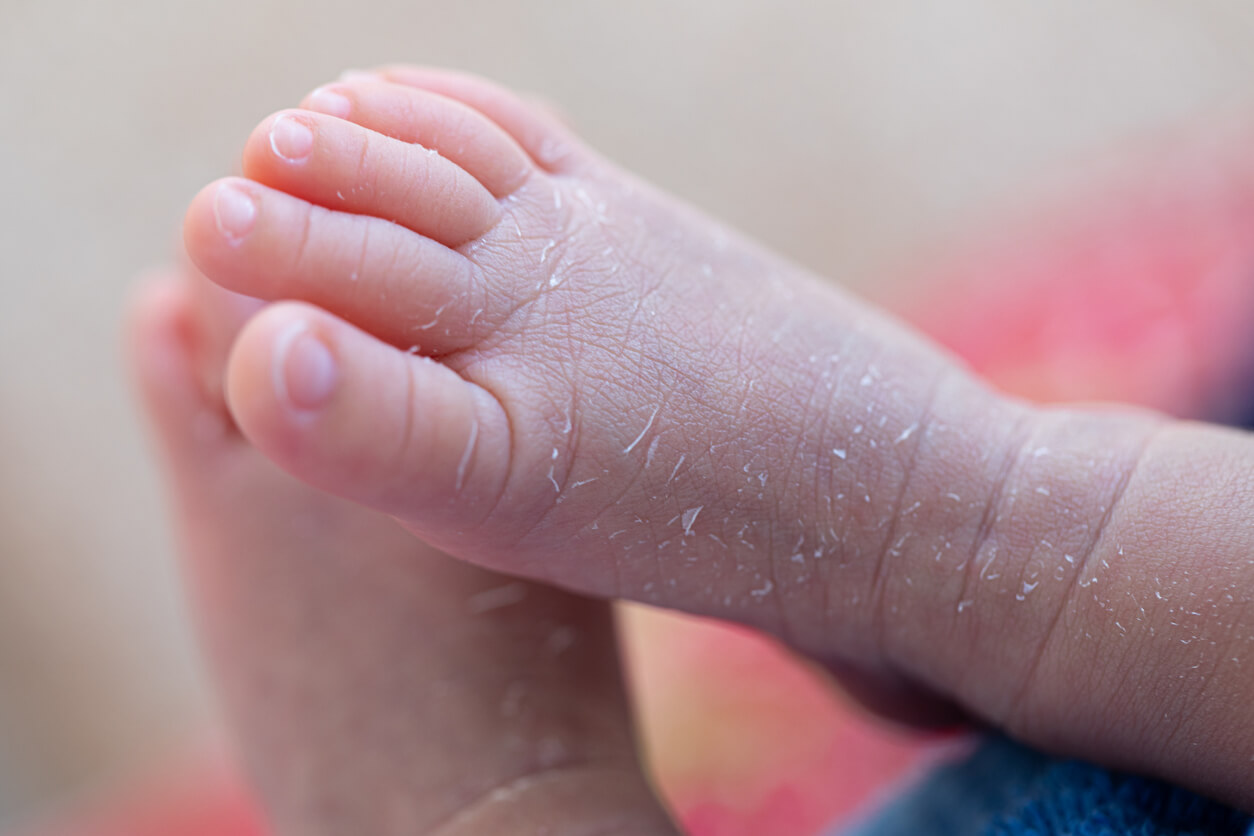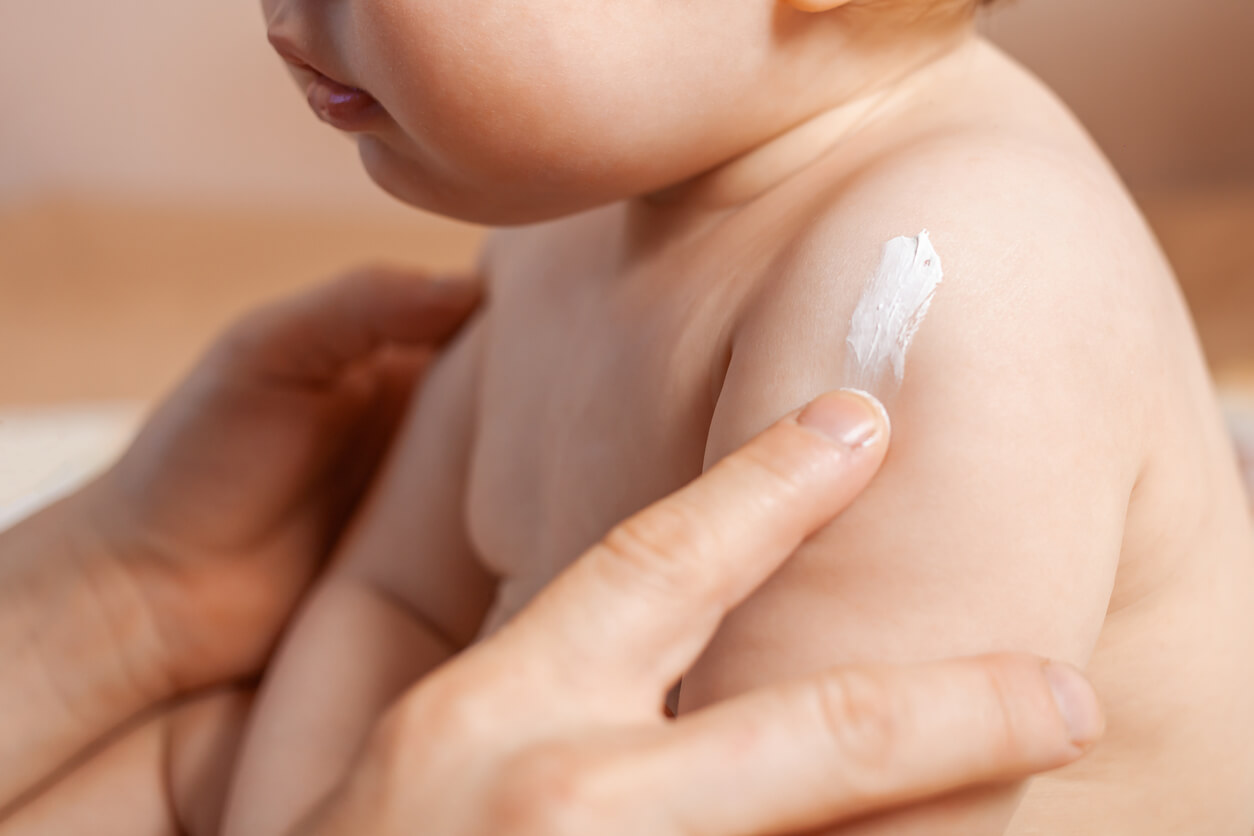Dry Skin in Infants


Written and verified by the dermatologist Maria del Carmen Hernandez
Newborn babies usually have dry skin due to certain characteristics of the surface of their skin. That’s to say, their skin is more delicate, sensitive, and fragile than the skin of adults. However, there are some measures that you can take to prevent dry skin in infants and keep it healthy and moisturized.
The causes of dry skin in infants
Although exposure to dry air and cold temperatures can weaken the skin’s own moisture, there are certain conditions that can occur in babies with dry skin.
Atopic dermatitis
Atopic eczema is a common skin condition that usually occurs during the first year of life. Moreover, in most cases, it’s the first manifestation of atopy and may coincide with food allergies.
Eczema can occur in any region of the body, but there are specific patterns that are more frequent at certain ages. In fact, in crawling infants, the forearms, knees, and flexor parts of the ankles tend to be most affected.
Read also: 3 Forbidden Foods for Children with Atopic Dermatitis
Psoriasis

Psoriasis is a common chronic inflammatory disease that affects the nails, skin, and joints. It even starts in infancy in about one-third of cases.
In fact, in infants, it appears in the form of a rash in the diaper area that’s resistant to conventional diaper rash treatment. In addition, it’s not a contagious condition.
What does dry skin in infants look like?
Some of the signs of dehydrated, dry skin in infants may include roughness, fine lines, flaking, or cracking. These signs can appear on any part of the body, but most often occur on the feet, hands, face, and lips.
Mildly dry skin doesn’t usually bother the baby too much. However, when it is too dry, it can be itchy and lead to scratching and injury.
Caring for babies and their dry skin
In addition to the pathological causes of dry skin in infants, there are factors that can cause or promote dehydration and subsequent dryness. For example, air conditioners, heaters, or chlorine from swimming pools are some of them.
Baths and routines
According to the recommendations of the American Academy of Pediatrics, short baths with lukewarm water are ideal. In addition, babies don’t require baths every day, even more so in winter or during humid periods.
The use of certain products can trigger dehydrated skin in children. Therefore, avoiding soaps and cosmetic products with perfumes or alcohol is a correct indication.
At the same time, there are certain oils that provide important functions at bath time. However, those containing antiseptics should be avoided, unless recommended by the specialist for the treatment of a specific infection.
You may be interested in: My Baby Has Reactive Skin
Moisturizing the skin

After bath time and rinsing, the baby’s delicate and fragile skin should be dried without rubbing with the towel. It’s at this moment when it’s advisable to apply a good moisturizing cream all over the body, although the type you choose will depend on the infant’s skin type:
- Ointments: These are those that contain a high proportion of oils in their composition, so they’re chosen for very dry and irritated skin. They don’t usually contain preservatives that cause any negative reaction in the skin.
- Creams: This type of product is useful for sealing moisture in the skin due to its large amount of oil.
- Emulsions: These are more fluid and lighter than the rest. For this reason, they’re chosen for not-so-dry skins and warmer periods.
The best clothing for dry skin in infants
The child’s clothing, as well as their bedding, should be cotton and soft fabrics so as not to cause irritation to the baby’s skin. In turn, washing with detergent without dyes, perfumes, or fragrances is ideal.
In addition, it’s best to wash all new clothing in order to remove any chemical residue or coloring product that remains on it.
Babies and dry skin
Caring for a baby’s skin is one of the most important aspects for parents. Although there are recommendations to prevent and treat dryness, if you have any doubts or concerns, you should consult your doctor.
Moisturizing and choosing the right cosmetic products for your baby are two of the essential pillars for maintaining healthy skin.
Newborn babies usually have dry skin due to certain characteristics of the surface of their skin. That’s to say, their skin is more delicate, sensitive, and fragile than the skin of adults. However, there are some measures that you can take to prevent dry skin in infants and keep it healthy and moisturized.
The causes of dry skin in infants
Although exposure to dry air and cold temperatures can weaken the skin’s own moisture, there are certain conditions that can occur in babies with dry skin.
Atopic dermatitis
Atopic eczema is a common skin condition that usually occurs during the first year of life. Moreover, in most cases, it’s the first manifestation of atopy and may coincide with food allergies.
Eczema can occur in any region of the body, but there are specific patterns that are more frequent at certain ages. In fact, in crawling infants, the forearms, knees, and flexor parts of the ankles tend to be most affected.
Read also: 3 Forbidden Foods for Children with Atopic Dermatitis
Psoriasis

Psoriasis is a common chronic inflammatory disease that affects the nails, skin, and joints. It even starts in infancy in about one-third of cases.
In fact, in infants, it appears in the form of a rash in the diaper area that’s resistant to conventional diaper rash treatment. In addition, it’s not a contagious condition.
What does dry skin in infants look like?
Some of the signs of dehydrated, dry skin in infants may include roughness, fine lines, flaking, or cracking. These signs can appear on any part of the body, but most often occur on the feet, hands, face, and lips.
Mildly dry skin doesn’t usually bother the baby too much. However, when it is too dry, it can be itchy and lead to scratching and injury.
Caring for babies and their dry skin
In addition to the pathological causes of dry skin in infants, there are factors that can cause or promote dehydration and subsequent dryness. For example, air conditioners, heaters, or chlorine from swimming pools are some of them.
Baths and routines
According to the recommendations of the American Academy of Pediatrics, short baths with lukewarm water are ideal. In addition, babies don’t require baths every day, even more so in winter or during humid periods.
The use of certain products can trigger dehydrated skin in children. Therefore, avoiding soaps and cosmetic products with perfumes or alcohol is a correct indication.
At the same time, there are certain oils that provide important functions at bath time. However, those containing antiseptics should be avoided, unless recommended by the specialist for the treatment of a specific infection.
You may be interested in: My Baby Has Reactive Skin
Moisturizing the skin

After bath time and rinsing, the baby’s delicate and fragile skin should be dried without rubbing with the towel. It’s at this moment when it’s advisable to apply a good moisturizing cream all over the body, although the type you choose will depend on the infant’s skin type:
- Ointments: These are those that contain a high proportion of oils in their composition, so they’re chosen for very dry and irritated skin. They don’t usually contain preservatives that cause any negative reaction in the skin.
- Creams: This type of product is useful for sealing moisture in the skin due to its large amount of oil.
- Emulsions: These are more fluid and lighter than the rest. For this reason, they’re chosen for not-so-dry skins and warmer periods.
The best clothing for dry skin in infants
The child’s clothing, as well as their bedding, should be cotton and soft fabrics so as not to cause irritation to the baby’s skin. In turn, washing with detergent without dyes, perfumes, or fragrances is ideal.
In addition, it’s best to wash all new clothing in order to remove any chemical residue or coloring product that remains on it.
Babies and dry skin
Caring for a baby’s skin is one of the most important aspects for parents. Although there are recommendations to prevent and treat dryness, if you have any doubts or concerns, you should consult your doctor.
Moisturizing and choosing the right cosmetic products for your baby are two of the essential pillars for maintaining healthy skin.
All cited sources were thoroughly reviewed by our team to ensure their quality, reliability, currency, and validity. The bibliography of this article was considered reliable and of academic or scientific accuracy.
- Cuidado de la piel de tu bebé. Salud infantil pediatra. 2007 marzo; 12 (3): 245-51. doi: 10.1093 / pch / 12.3.245. PMID: 19030369; PMCID: PMC2528704.
- Augustin M, Glaeske G, Radtke MA, Christophers E, Reich K, Schäfer I. Epidemiology and comorbidity of psoriasis in children. Br J Dermatol. 2010 Mar;162(3):633-6. doi: 10.1111/j.1365-2133.2009.09593.x. Epub 2009 Nov 18. PMID: 19922529.
- Blume-Peytavi U, Hauser M, Stamatas GN, Pathirana D, Garcia Bartels N. Skin care practices for newborns and infants: review of the clinical evidence for best practices. Pediatr Dermatol. 2012 Jan-Feb;29(1):1-14. doi: 10.1111/j.1525-1470.2011.01594.x. Epub 2011 Oct 20. PMID: 22011065.
This text is provided for informational purposes only and does not replace consultation with a professional. If in doubt, consult your specialist.








